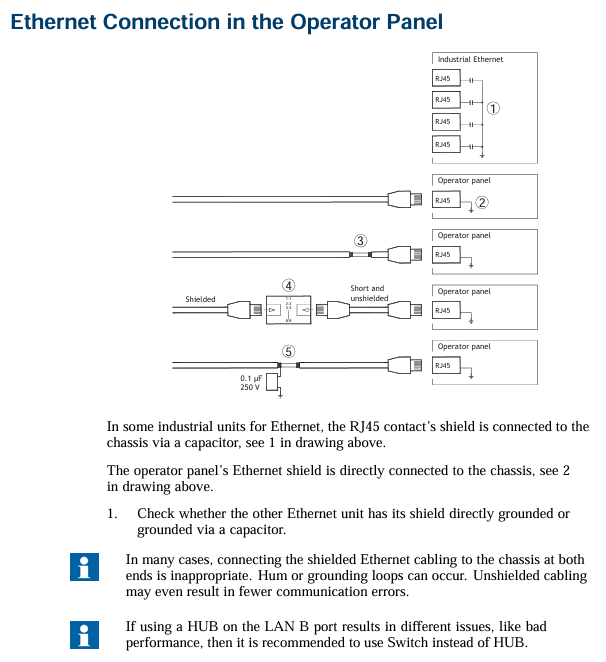ABB Panel 800 Version 6 PP885 Hardware and Installation
Potential risks and solutions: In small controllers, if the 24V relay contacts are mixed with the 230V AC relay contacts, it may compromise the safety of 24V DC power supply. It is necessary to check whether the electrical clearance and creepage distance between 24V DC and 230V AC comply with EN 60950 or UL 950 standards. If they do not comply, a separate 24V power supply needs to be configured for the operation panel; If the distance between the contacts of 24V DC and 230V AC relays is large enough, the same 24V device can be used to power all devices; There are three advantages to grounding a 24V power supply with 0V: improving safety (if there is a connection error or short circuit between the 0V (24V) and 230V phase lines, the 24V power supply will not be charged), guiding transient signals on the 24V power supply to the ground, and avoiding the 24V power supply being at a high potential relative to the ground (which is prone to occur when static electricity is high).
(6) Galvanic isolation
Isolation feature: The operation panel has electrical isolation for 24V DC power supply, but there is no electrical isolation between communication ports such as RS232, RS422/485, and USB. Only Ethernet connections have electrical isolation.
Grounding and communication risks: When the PC is connected to the operation panel, the internal 0V (GND) of the panel is connected to the protective ground through the PC; The shielding layer of multiple USB devices may be connected to the protective ground, for example, when inserting USB flash drives, keyboards, and other devices, the 0V (GND) of the operation panel will be connected to the protective ground; If multiple devices have 0V and ground connections, and are connected to different grounding points, it is highly likely to cause problems. Grounding current may pass through communication cables, controller backplanes, and the interior of the operation panel, leading to errors.
Improvement measures: External devices can be used to improve communication and achieve electrical isolation, such as Westermo's industrial standard isolator (also isolated from 24V DC feed); It is necessary to ensure that the 24V power supply of the external isolator is not connected to any communication output terminal. If it is not 100% isolated from the 24V power supply, the interference of 0V on the 24V side and the grounding current will interfere with communication. Such equipment may solve one problem but cause bigger problems. Improper installation may temporarily work normally, but faults may occur when connecting other devices.
(7) RS485 cable and bus terminal
Cable requirements: If maximum transmission distance and maximum transmission speed are required, shielded twisted pair cables should be used, with a mutual capacitance not exceeding 52.5pF/m and a cable cross-sectional area of at least 0.25mm ² (AWG 24); The communication reference voltage of 0V should be included in the cable, and bidirectional communication requires the use of two pairs of wires (one pair for communication and one pair for 0V).
Shielding and termination: The shielding layer needs to be grounded at one end, and the other end is usually also grounded. However, when long-distance transmission or grounding potential is different, the shielding layer should be grounded through a 0.1 μ F/250V plastic capacitor to prevent grounding current from being generated in the braided shielding layer; Different manufacturers have different systems for bus terminals. Depending on the design of the receiving end, the bus wires may be at the same level or require pull-up/pull-down resistors to ensure that no error signals are detected when the bus is in idle mode (all transmitters are disconnected).

- EMERSON
- Honeywell
- CTI
- Rolls-Royce
- General Electric
- Woodward
- Yaskawa
- xYCOM
- Motorola
- Siemens
- Rockwell
- ABB
- B&R
- HIMA
- Construction site
- electricity
- Automobile market
- PLC
- DCS
- Motor drivers
- VSD
- Implications
- cement
- CO2
- CEM
- methane
- Artificial intelligence
- Titanic
- Solar energy
- Hydrogen fuel cell
- Hydrogen and fuel cells
- Hydrogen and oxygen fuel cells
- tyre
- Chemical fiber
- dynamo
- corpuscle
- Pulp and paper
- printing
- fossil
- FANUC
- Food and beverage
- Life science
- Sewage treatment
- Personal care
- electricity
- boats
- infrastructure
- Automobile industry
- metallurgy
- Nuclear power generation
- Geothermal power generation
- Water and wastewater
- Infrastructure construction
- Mine hazard
- steel
- papermaking
- Natural gas industry
- Infrastructure construction
- Power and energy
- Rubber and plastic
- Renewable energy
- pharmacy
- mining
- Plastic industry
- Schneider
- Kongsberg
- NI
- Wind energy
- International petroleum
- International new energy network
- gas
- WATLOW
- ProSoft
- SEW
- wind
- ADVANCED
- Reliance
- YOKOGAWA
- TRICONEX
- FOXBORO
- METSO
- MAN
- Advantest
- ADVANCED
- ALSTOM
- Control Wave
- AB
- AMAT
- STUDER
- KONGSBERG
- MOTOROLA
- DANAHER MOTION
- Bently
- Galil
- EATON
- MOLEX
- Triconex
- DEIF
- B&W
- ZYGO
- Aerotech
- DANFOSS
- KOLLMORGEN
- Beijer
- Endress+Hauser
- MOOG
- KB
- Moxa
- Rexroth
- YAMAHA


Email:wang@kongjiangauto.com































































































































